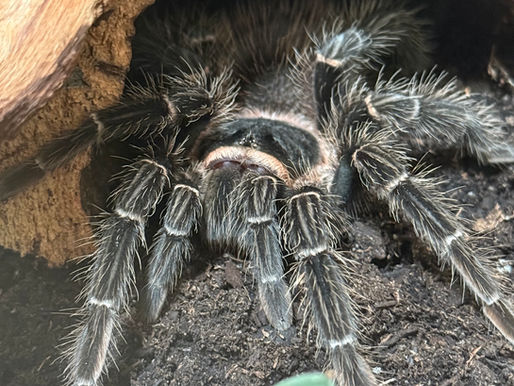top of page
New World South America


Psalmopoeus
Species of this genus are native to Central America and northern South America. All species are arboreal, and many are fast moving with slightly more potent venom than other new world species. Genus and species: Psalmopoeus victori Common name: Darth Maul Given name: Nihlus This species is native to Mexico and is the only arboreal species from Mexico. They have unique coloration with red on the abdomen and back legs and black on the carapace and front legs. Habitat: they resi


Chromatopelma
There is only one species in this genus -- the C. cyaneopubescens. This is a hobby staple. Genus and species: Chromatopelma cyaneopubescens Common name: Green Bottle Blue Given name: Sophie This is an iconic species in the hobby given its remarkable coloration, relatively calm demeanor, hardiness, and its tendency to be on display. This species hails from northern Venezuela. They prefer arid climates and tend to be semi-arboreal. They are heavy webbers. This species reaches a


Ybyrapora
This genus includes three accepted arboreal species from Brazil that were formerly included in Avicularia. Genus and species: Ybyrapora diversipes Common name: Amazon Sapphire Given name: Oakley Y. diversipes is an arboreal species native to Brazil. This species has beautiful coloration with blues, greens, purples, reds and oranges. Adults can reach 5 inches. They are considered to be fast and skittish. Habitat: Amazon rainforest regions where it constructs webs in crevices a


Cyriocosmus
There are 23 accepted species of Cyriocosmus, which are found in South America, Trinidad and Tobogo. All species have type 3 urticating...


Nhandu
This genus comprises a relatively small number of small from South America. There are four accepted Nhandu species, with two additional in synonymy. These species are primarily found in Brazil. Genus and species: Nhandu tripepii Common name: Brazilian giant blonde Given name: Emily This species is native to the State of Para, Brazil, described from the Golas region. They can be skittish, defensive, and aggressive. This species is considered a senior synonym to Nhandu vulpinus


Avicularia
This genus comprises arboreal species that can be found throughout Mexico, Costa Rica, Panama, Trinidad and Tobago, Venezuela, Guyana, Suriname, French Guiana, Colombia, Ecuador, Peru, Bolivia, and Brazil. All of the Avicularia species have pink foot pads. Certain species have been known to jump short distances. Many species in this genus have been transferred to other genera. Currently, there are 12 accepted Avicularia species. Historically, over 50 species were classified a


Theraphosa
The Theraphosa genus currently includes three accepted species (stirmi, blondi, aphophysis). All are very large and considered the largest tarauntula species in the world. They are typically found in Guyana, Brazil, Venezuela, and Columbia. They species requires humidity, which should be monitored. They are large enough to consume vertebrate prey items. There is a so-called fourth "accepted" species, which is T. spinipes. However, this classification may not be universally a


Grammostola
This genus originates from South America, namely Brazil, Uruguay, and Argentina among other countries. This genus includes some very...


Lasiodora
The Lasiodora genus includes a relatively modest number of species, all of which are found in Brazil. Many species that were originially classified as Lasiodora have been reclassified into other genera. The current list of Lasiodora includes large size species. The most recent taxonomic revision and analysis of this genus was publihsed by Bertani in 2023. Several species have been reclassified, in synonymy, or nomina dubia. The accepted species are: Lasiodora benedeni (ex dif


Lasiodorides
The Lasiodorides genus is limited to two species, primarily from Peru. Sherwood 2021 redescribed the Lasiodorides genus. Genus and species: Lasiodorides polycuspulatus Common name: Peruvian Blonde Given name: Latte L. polycuspulatus is a slow growing and generally docile species from northeastern Peru. Females reach an adult size of 5 to 6 inches. They are common in the hobby given their disposition and lack of aggressiveness. Habitat: Creates burrows around and under rocks a


Vitalius
The genus Vitalius includes a moderate number (n = 11 accepted) of South American species, typically from Brazil and less so from Argentina. Few species are available in the hobby. Genus and species: Vitalius chromatus Common name: Brazilian red and white Given name: Twix This species was considered a Lasiodora, then a Nhandu, and now a Vitalius. Source: Peters 2005 Husbandry Notes: Enclosure: 12x12x12 Sex: Male Life stage: Mature Size: Approximately 6 inches but mostly legs


Xenesthis
The Xenesthis genus contains relatively few species, but of their species, they tend to exhibit vibrant coloration. This species hails from Columbia and Venezuela. Five Xenesthis species are currently accepted by scientific classifications. This genus is summarized by Sherwood 2023. Genus and species: Xenesthis sp. white Common name: Columbian Lesser White Given name: Zoe This species... Husbandry Notes: Enclosure: 12x12x12 Sex: Female Life stage: sub-adult Size: Approximatel


Acanthoscurria
The Acanthoscurria genus is found throughout South America, spanning several countries. Some species have been identified in the West Indies. This genus includes 19 accepted species with several in synonymy and nomina dubia. The most common species in the hobby is A. geniculata (Brazilian whiteknee). Genus and species: Acanthoscurria sp. maldonadoensis (undescribed, not even listed as nomina dubia) Common name: Maldonado birdeater Given name: Mahogany This species is allegedl
bottom of page